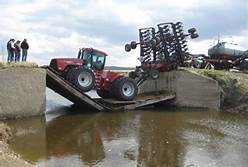 Washington DC Tripnet.org reports that 11% of North Dakota’s rural bridges are rated as poor/structurally deficient.
Washington DC Tripnet.org reports that 11% of North Dakota’s rural bridges are rated as poor/structurally deficient.
It’s the 12th highest share in the U.S. Bridges that are poor/structurally deficient, have significant deterioration to the major components of the bridge and are often posted for lower weight or closed to traffic, restricting or redirecting large vehicles, including agricultural equipment, commercial trucks, school buses and emergency services vehicles.
The report finds that 19 percent of North Dakota’s rural roads are rated in poor or mediocre condition. The rate of traffic fatalities on North Dakota’s non-Interstate, rural roads is nearly four-and-a-half times higher than the fatality rate on all other roads in the state – 1.83 fatalities per 100 million vehicle miles of travel vs. 0.42.
North Dakota Chamber of Commerce, President and CEO, Arik Spencer says, “The TRIP report demonstrates the need for increased and continued investment in North Dakota’s transportation system, particularly our network of rural roads and bridges, which provide a vital link for the state’s agricultural, energy extraction and tourism sectors and keep our economy moving in the right direction.”
North Dakota spokesman for AAA-The Auto Club Group, Gene LaDoucer says, “Rural roads play a critical role in supporting the transportation needs of North Dakotans every day. Damaged and structurally deficient bridges and deteriorating roadways impact everyone, and it’s time to focus on these critical needs. Making the necessary improvements to rural roads and bridges will help move our economy forward and save lives.”
The TRIP report finds that the U.S. needs to implement transportation improvements that will improve rural transportation connectivity, safety and conditions to provide the nation’s small communities and rural areas with safe and efficient access to support quality of life and enhance economic productivity.












Comments are closed
Sorry, but you cannot leave a comment for this post.